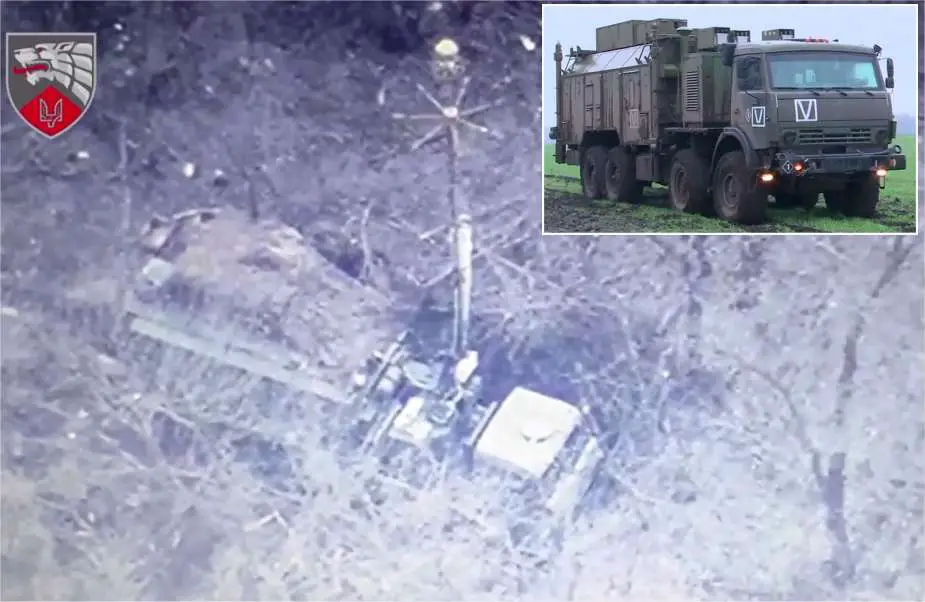Ukraine's Special Forces destroy latest Russian Palantin electronic warfare system
On March 11, 2024, Ukrainian Special Operations Forces conducted an operation resulting in the destruction of a Russian Palantin electronic warfare system in the Zaporizhzhia region. The Palantin system, introduced into the Russian military in April 2019, represents the latest advancement in Russia's operational-tactical level electronic warfare capabilities.
Follow Army Recognition on Google News at this link

The Russian Palantin EW system was conducting radio-electronic reconnaissance and disrupting Ukrainian communication systems in the Zaporizhzhia region. (Picture source: Ukraine SOF and Russian social media)
According to the Ukrainian military's press service, reconnaissance operators of the 3rd separate regiment of the Special Operations Forces detected the Russian Palantin electronic warfare system, which was reported to be conducting radio-electronic reconnaissance and disrupting Ukrainian communication systems in the area. Following reconnaissance, the location and details of the Palantin system were transmitted to a Ukrainian missile and artillery unit, which subsequently carried out a strike using two GMLRS rockets fired from a HIMARS system, resulting in the destruction of the Palantin electronic warfare system.
The Palantin electronic warfare (EW) system, developed and manufactured by JSC Concern Sozvezdie, which is part of the Rostec corporation, was introduced into the Russian military in April 2019. The system's primary function is to conduct electronic reconnaissance and suppress both current and emerging enemy communication systems. It operates on a software-defined radio (SDR) platform, enabling various types of EW operations. The Palantin-K, whose status as either another designation or a variant of the Palantin remains unclear, focuses on suppressing enemy radio communication systems and conducting electronic reconnaissance.
Russians themselves said that the Palantin has significantly enhanced capabilities compared to previous generations of Russian EW systems and noted it for its unique features not found in similar systems used by other countries. According to Russian military expert Konstantin Sivkov, the Palantin system could affect the guidance systems of precision-guided weapons such as the Tomahawk missile, potentially redirecting them from their intended targets.
The Palantin's electronic warfare equipment is designed to suppress various forms of enemy communications and reconnaissance, including radio stations at headquarters, radar systems used in artillery or aviation, and control signals for bombs and cruise missiles. By interfering with these signals, the Palantin can disrupt enemy command and control capabilities, potentially leading to scenarios where troops may not receive necessary orders, and aerial and missile assets could lose navigation and targeting information.

The deployment time for the Palantin EW system, mounted on KamAZ-63501 8x8 chassis, is reported to be no more than 30 minutes. (Picture source: Russian social media)
The Palantin is engineered to automatically create a protective dome over its units upon deployment, enabling effective detection and counteraction of drones and other enemy equipment. It has an operational range of over 20 kilometers, targeting specific points rather than using a directed beam, thus allowing for disruption of enemy communications and internet connections without impacting surrounding civilian infrastructure.
In addition to hindering short-wave and ultra-short-wave communications, the Palantin can integrate various EW and electronic reconnaissance systems, such as the Moskva-1, R-330Zh Zhitel, and MKTK-1A "Dzudoist", into a unified combat network, potentially enhancing their collective effectiveness. The system also includes an automated decision support system, designed to autonomously generate optimal task execution algorithms and manage the distribution of resources and tasks across its components. The Palantin entire system consists of 22 vehicles deployed along the front line, which can operate in a single coordinated network to provide concealment for an entire army from enemy surveillance.
In terms of reconnaissance capabilities, the Palantin system can perform radio reconnaissance on communication centers and high frequency (HF), very high frequency (VHF) lines including terrestrial, aviation, cellular, and trunk radio communications, as well as ground terminals of satellite and radio relay communications. Additionally, the system can be tasked with generating targeted discrete-barrier, band-barrier, and frequency-barrier interference against identified targets for electronic suppression.
Mounted on KamAZ-63501 8x8 chassis, the Palantin system completed military testing in 2019 and is now operational within the Russian Forces in Ukraine. The deployment time for the Palantin is reported to be no more than 30 minutes. Accounts from Russian military personnel, including a fighter with the call sign "Shar," have provided insights into the operational impact of the Palantin system on Ukrainian drones. According to these reports, the Palantin disrupts enemy drones by interfering with their video recording capabilities, resulting in deviations from their intended flight paths or hovering until their power is depleted.
Furthermore, a commander of a Russian radio jamming company located in Ukraine, identified as Sergei, has detailed the Palantin system's capabilities in disrupting the control channels of unmanned aerial vehicles (UAVs). This disruption prevents enemy operators from maintaining control over their drones. Additionally, the Palantin's jamming capabilities extend to cellular communications and tactical internet connections, enabling it to disrupt communication networks and internet access at Ukrainian command posts.























